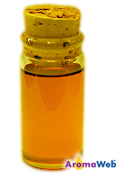Styrax Benzoin Absolute
Styrax benzoin / Styrax tonkinensis

Description
Styrax Benzoin possesses a sweet, warming, rich, vanilla-like aroma with resinous undertones. It is derived from the resin of the Styrax Benzoin tree. I've also heard reference to this tree being called the Gum Benjamin Gum. Styrax Benzoin Resin has traditionally been used in incense applications. The resin normally is available in chunks or can be powderized just prior to use (the powder will re-harden if left too long).

For aromatherapy, the hard resinous material is solvent extracted to create a thick, sticky absolute. Because it can be quite thick, some suppliers may package it in a jar instead of bottle. For tips, see Working With and Blending Thick Aromatic Oils.
Emotionally, Styrax Benzoin Absolute is calming and grounding. In Chakra work, it is a recommended oil for use with the Root Chaka.
Stryax Benzoin blend well with other resinous oils like Frankincense or Myrrh. It also blends well with wood oils like Sandalwood and Cedarwood. It marries well with a hint of Vetiver and/or Patchouli. With its vanilla-like character, Styrax Benzoin has a special affinity for use with citrus essential oils. I especially like it with characteristically "orange" oils that include Sweet Orange, Mandarin, Tangerine and Bergamot. It likely smells divine blended with Yuzu Essential Oil.

I traditionally diffuse Benzoin using my candle diffuser. Because it is so thick, it should not be used in nebulizing diffusers or any style diffusing apparatus that doesn't work well with thick oils.
Styrax Benzoin may cause sensitization. Topically, use it with extreme care and in low dilutions. See below for additional information about Styrax Benzoin Resin.
Styrax Benzoin Resin Benefits and Uses
- Arthritis
- Bronchitis
- Chapped Skin
- Coughing
- Laryngitis
- Stress
Source: Julia Lawless, The Encyclopedia of Essential Oils (Updated Edition) (London: Harper Thorsons, 2014), 47-48.
Botanical Name
Styrax benzoin / Styrax tonkinensis
Plant Family
Common Method of Extraction
Solvent Extracted
What is an Absolute?
Plant Part Typically Used
Color
Golden Brown
Consistency
Thick Viscosity. Can be tricky to work with. For tips, see Working With and Blending Thick Aromatic Oils.
Perfumery Note
Base
Strength of Initial Aroma
Light-Medium
Aromatic Description
Styrax Benzoin Absolute smells rich, warm, slightly woody, creamy and has vanilla-like characteristics.
Sustainability and Conservation Status
Least Concern
Source: https://www.iucnredlist.org/species/147364203/147655260
To learn more about the conservation status of essential oil bearing plants and how to use the IUCN Red List of Threatened Species, please refer to AromaWeb's Guide to Essential Oils and Sustainability.
Major Constituents for Benzoin from Sumatra
- Benzyl Benzoate
- Benzyl Alcohol
- (Z)-Cinnamyl (E)-Cinnamate
- Cinnamic Acid
- Ethyl Cinnamate
- Benzoic Acid
Source: D.A. Moyler, The Flavour Gum Resins, Their Chemistry and Uses. (Rivista Italiana EPPOS (Numero Speciale), 1998), 351-360. Source cited in Robert Tisserand and Rodney Young, Essential Oil Safety (Second Edition. United Kingdom: Churchill Livingstone Elsevier, 2014), 210.
Major Constituents for Benzoin from Siam
Benzyl Benzoate
Benzyl Alcohol
Benzoic Acid
Ethyl Cinnamate
[D.A. Moyler, The Flavour Gum Resins, Their Chemistry and Uses. (Rivista Italiana EPPOS (Numero Speciale), 1998), 351-360. Source cited in Robert Tisserand and Rodney Young, Essential Oil Safety (Second Edition. United Kingdom: Churchill Livingstone Elsevier, 2014), 210.]
Styrax Benzoin Absolute Safety Information
Tisserand and Young indicate that there is generally a low risk of sensitization. They recommend a dermal maximum of 2% and advise to use with caution with skin that is hypersensitive or damaged/diseased. Reading Tisserand and Young's full profile is recommended. [Robert Tisserand and Rodney Young, Essential Oil Safety (Second Edition. United Kingdom: Churchill Livingstone Elsevier, 2014), 210.]
Styrax Benzoin Resin may cause possible skin sensitivity and contact dermatitis. [Leung, A.Y. Encyclopedia of Common Natural Ingredients, 64 as cited in Julia Lawless, The Illustrated Encyclopedia of Essential Oils (Rockport, MA: Element Books, 1995), 222.]
General Safety Information
Do not take any oils internally and do not apply undiluted essential oils, absolutes, CO2s or other concentrated essences onto the skin without advanced essential oil knowledge or consultation from a qualified aromatherapy practitioner. For general dilution information, read AromaWeb's Guide to Diluting Essential Oils. If you are pregnant, epileptic, have liver damage, have cancer, or have any other medical problem, use oils only under the proper guidance of a qualified aromatherapy practitioner. Use extreme caution when using oils with children and be sure to first read the recommended dilution ratios for children. Consult a qualified aromatherapy practitioner before using oils with children, the elderly, if you have medical issues or are taking medications. Before using this or any essential oil, carefully read AromaWeb's Essential Oil Safety Information page. For in-depth information on oil safety issues, read Essential Oil Safety by Robert Tisserand and Rodney Young.
Shelf Life
Important Information About the Profiles
The essential oil information provided on AromaWeb is intended for basic educational purposes only. The references to safety information, test results, constituents and percentages is generalized information. Essential oils can vary greatly in composition. The data is not necessary complete and is not guaranteed to be accurate. The essential oil photos are intended to represent the typical and approximate color of each essential oil. However, essential oil composition and color can vary based on harvesting, distillation, age of the essential oil and other factors. Profiles for several CO2 Extracts and absolutes are included within the directory, and are denoted as such.
